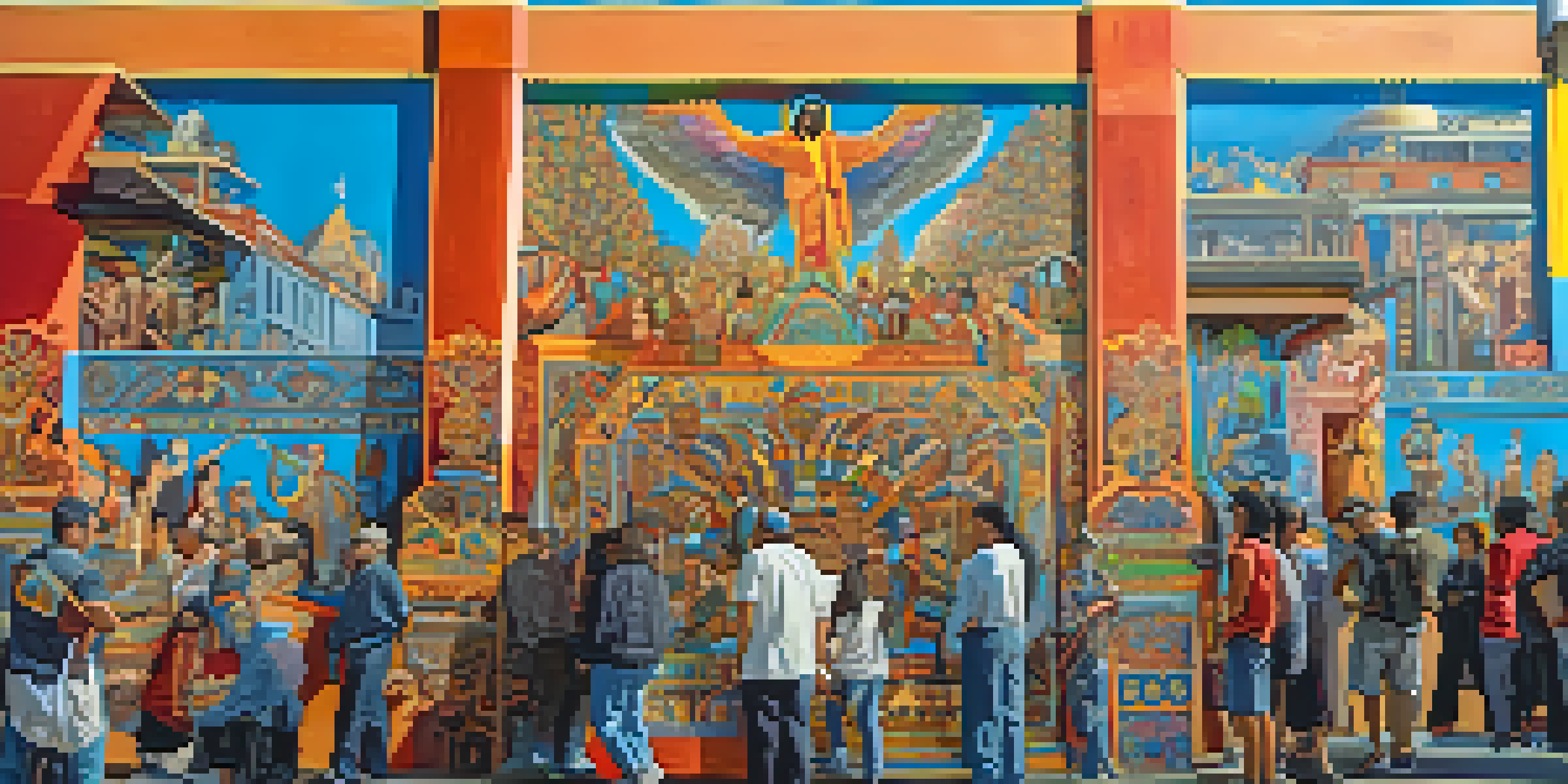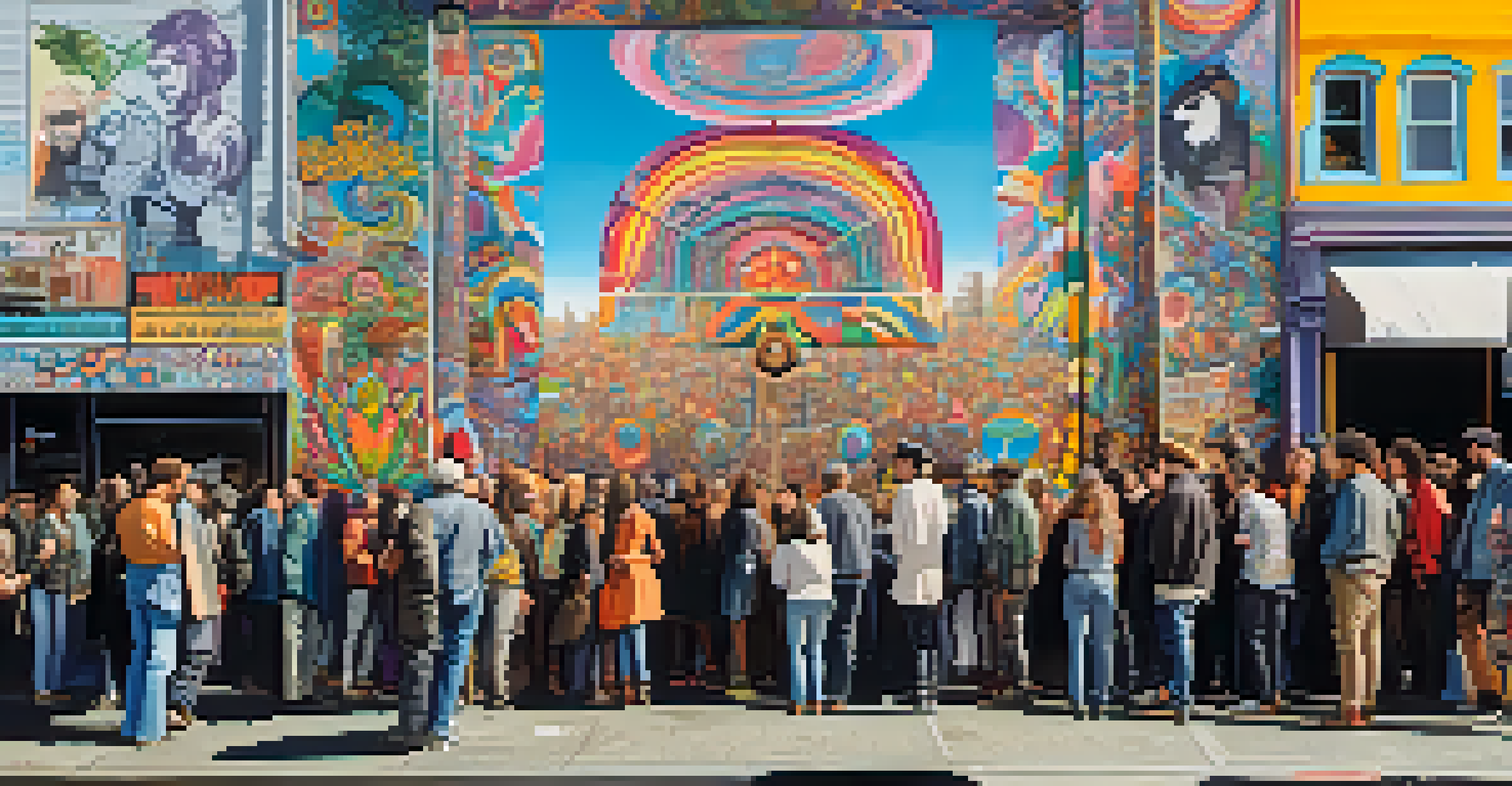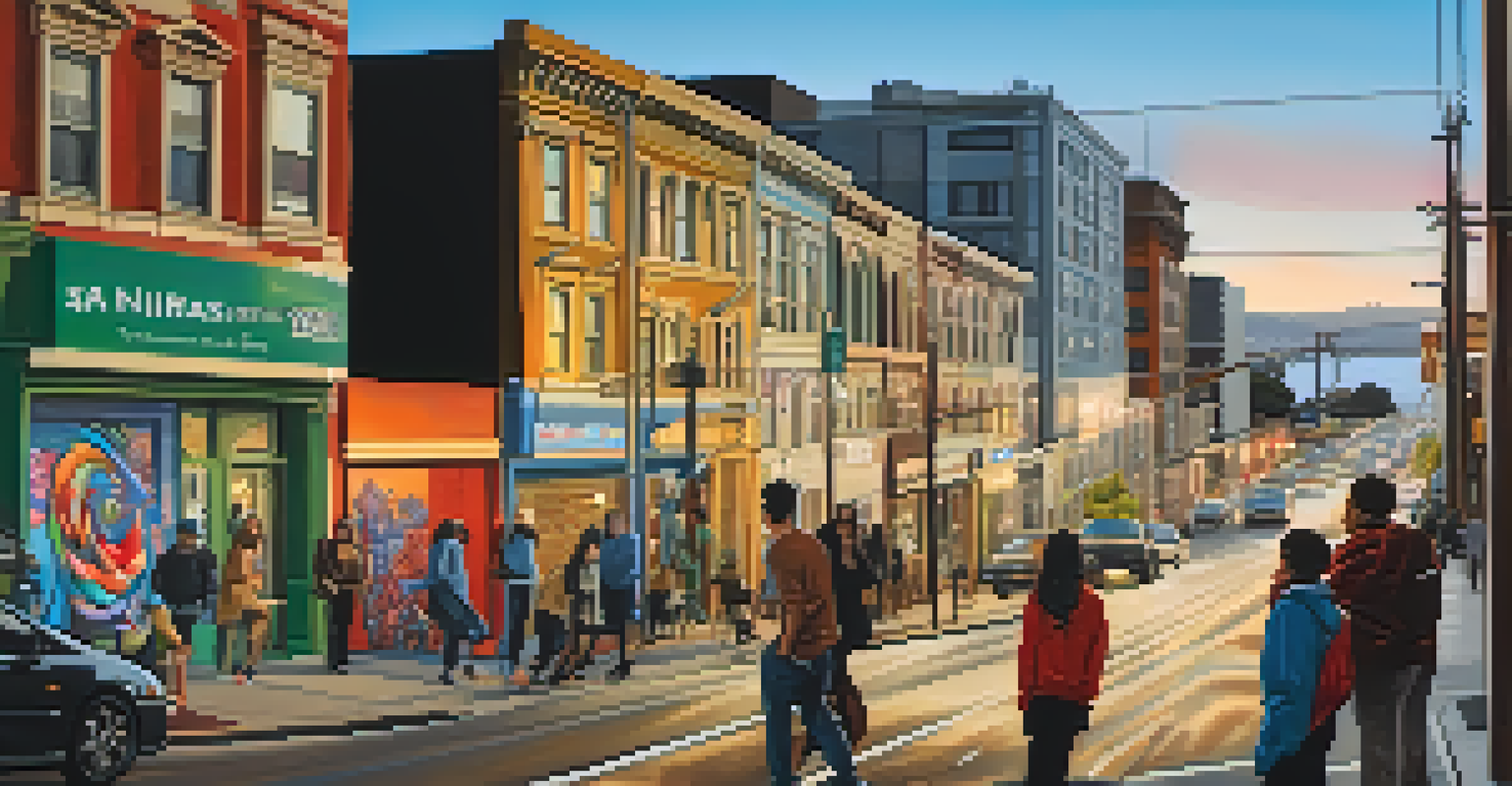The Role of Street Art in San Francisco's Cultural Identity

The Historical Roots of Street Art in San Francisco
San Francisco's street art scene has deep historical roots that reflect the city's diverse culture. Emerging from the counterculture movements of the 1960s and 1970s, murals became a canvas for social commentary and artistic expression. Artists used public spaces to voice their opinions on societal issues, creating a vibrant tapestry of colors and messages throughout the city.
Art is not what you see, but what you make others see.
One of the most iconic examples is the Mission District, where murals celebrate cultural heritage and address political themes. These artworks are not just for aesthetics; they serve as a historical record and a form of activism. The evolution of street art in this area illustrates how local communities can reclaim public spaces and assert their identities.
Today, street art in San Francisco continues to evolve, drawing in artists from around the globe. This blend of local and international influences enriches the cultural landscape, making the city a hub for creativity and innovation. As we look at street art's historical roots, we begin to understand its ongoing significance in shaping community narratives.
Street Art as a Form of Social Commentary
Street art often serves as a powerful medium for social commentary, addressing issues such as inequality, gentrification, and climate change. In a city like San Francisco, where socioeconomic disparities are evident, artists use their work to provoke thought and inspire dialogue. This art form challenges viewers to confront uncomfortable truths about the urban environment they inhabit.

For instance, murals depicting the struggles of marginalized communities highlight their voices and experiences. These artworks become a form of resistance, encouraging community engagement and activism. By transforming blank walls into canvases for expression, street artists bring attention to critical issues that might otherwise go unnoticed.
Street Art Reflects Community Identity
San Francisco's street art captures the essence of neighborhoods, showcasing the struggles and cultural heritage of local residents.
Moreover, the accessibility of street art allows it to reach a broader audience than traditional galleries. People from all walks of life can engage with these messages, fostering a sense of community and shared understanding. As we explore the role of street art in social commentary, we see how it can inspire change and promote awareness.
The Intersection of Street Art and Local Identity
Street art is a reflection of local identity, capturing the essence of neighborhoods and their inhabitants. In San Francisco, each area has its unique character, which is often expressed through the vibrant murals and graffiti that adorn its walls. These artworks tell stories about the people who live there, their struggles, dreams, and cultural heritage.
Street art is a way of life for those who want to express themselves without the constraints of traditional art forms.
Take the Haight-Ashbury district, for example, where murals celebrate the legacy of the 1960s counterculture. These artworks not only pay homage to the past but also influence the ongoing narrative of the community. By showcasing local themes and historical references, street art helps forge a sense of belonging among residents.
As neighborhoods evolve, so too does their street art, which adapts to reflect changing identities. This dynamic relationship between street art and local culture highlights how art can be both a mirror and a catalyst for community identity. Understanding this intersection enriches our appreciation of San Francisco's cultural landscape.
Collaboration Between Artists and Communities
Collaboration between artists and communities plays a vital role in the creation of street art. Many local artists work closely with residents to ensure that their murals resonate with the community's values and experiences. This partnership fosters a sense of ownership and pride in the artwork, reinforcing the connection between the art and the people.
Community-driven projects often emerge from grassroots initiatives, where residents identify the need for artistic representation in their neighborhoods. These collaborations not only result in stunning visual displays but also strengthen community bonds and encourage collective creativity. When artists and community members come together, the result is a richer, more authentic representation of local identity.
Art as Social Commentary
Street art serves as a powerful medium for addressing social issues like inequality and gentrification, provoking thought and dialogue among viewers.
Moreover, these collaborations can serve as a platform for underrepresented voices, allowing them to share their stories through art. By prioritizing inclusivity and participation, street art becomes a vehicle for empowerment, helping communities articulate their narratives. This collaborative spirit highlights the importance of community engagement in the street art movement.
The Role of Street Art in Tourism
Street art has become a significant draw for tourists visiting San Francisco, adding an exciting layer to the city's cultural offerings. Visitors flock to neighborhoods like the Mission District and North Beach, eager to experience the vibrant murals and learn about the stories behind them. This influx of tourists not only boosts the local economy but also raises awareness of the artistic community.
As tourists explore these areas, they often engage with the art in a personal way, taking photos and sharing their experiences on social media. This visibility contributes to a broader appreciation for street art as a legitimate art form. By capturing the attention of visitors, these murals help solidify San Francisco's reputation as a hub of creativity and innovation.
However, this rise in tourism also brings challenges, such as the risk of commercialization and the displacement of local artists. It's essential for the community to maintain a balance that honors the original intent of street art while embracing its role in attracting visitors. Understanding the impact of tourism on street art is crucial for preserving its authenticity and cultural significance.
Challenges Facing San Francisco's Street Art Scene
Despite its vibrant presence, San Francisco's street art scene faces several challenges that threaten its sustainability. One major issue is the ongoing battle against gentrification, which often leads to the erasure of beloved murals and the displacement of local artists. As neighborhoods undergo rapid changes, many artists find it increasingly difficult to secure spaces for their work.
Moreover, legal restrictions surrounding graffiti can stifle creativity and limit opportunities for artists. While some street art is celebrated, others are viewed as vandalism, leading to potential legal consequences for creators. This dichotomy creates an environment where artists must navigate complex regulations while trying to express themselves freely.
Collaboration Fuels Street Art Growth
Partnerships between artists and communities enhance the authenticity of street art, allowing for meaningful representation of local narratives.
Additionally, the commercialization of street art can dilute its original intent, as some works become mere tourist attractions rather than genuine expressions of community identity. Addressing these challenges requires a collective effort from artists, community members, and policymakers to ensure that San Francisco's street art continues to thrive and reflect the city's rich cultural heritage.
The Future of Street Art in San Francisco
As we look to the future, the role of street art in San Francisco's cultural identity will likely continue to evolve. With the rise of new technologies and platforms, artists may explore innovative ways to engage with their audiences, such as augmented reality and digital installations. These advancements could open up new avenues for expression and interaction, further enriching the city's artistic landscape.
Furthermore, as communities navigate the challenges of gentrification and commercialization, there is a growing emphasis on preserving the authenticity of street art. Initiatives that promote local artists and encourage public participation in art projects can help maintain the vibrant spirit of San Francisco's streets. By prioritizing community engagement, the city can ensure that its street art remains a true reflection of its diverse populations.

Ultimately, the future of street art in San Francisco will depend on the continued collaboration between artists and communities. By fostering an environment that values creativity, inclusivity, and dialogue, the city can ensure that its street art scene remains dynamic and relevant. As we embrace this future, we celebrate the power of street art to inspire, connect, and transform.